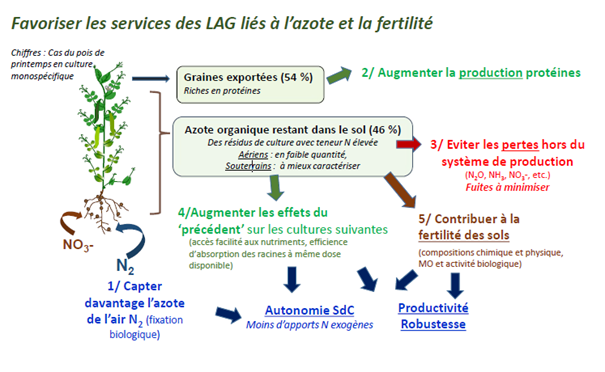Seed legumes, a lever for farm profitability
Seed legumes, a lever for farm profitability
During the annual Innovation Research Development (IRD) day in Occitania, Terres Inovia explained the effects of the previous crop in the case of leguminous crops to allow greater robustness of systems and better resilience of farms.
On February 14, in Ondes (31), the Occitania Regional Chamber of Agriculture co-organized the annual IRD day with Terres Inovia and Arvalis for advisors, with the theme of farm resilience, and more specifically, "what levers can be used to maintain production and economic profitability of farms in Occitania?
Less nitrogen and more productivity
Maintaining productivity and/or using less nitrogen is a growing concern for producers, with the leveling off or even the decrease in yields of the main crops, the soaring price of energy and nitrogen, and the acceleration of climate change (linked to greenhouse gases, to which nitrous oxide from plant production contributes).
However, it is possible to de-cap the yields of the dominant crops with a leguminous crop precedent, with, for example, an average increase of +8 quintals for pea wheat compared to cereal wheat in France (variability of 0 to +20 quintals for this increase) while reducing the dose applied (data observed over several years in 7 small agricultural regions). This data needs to be better documented according to the regions and species concerned.
For nitrogen, on the scale of agricultural practices in the Midi-Pyrénées, cropping systems with seed legumes (LAG) - a very small minority - have an average nitrogen dose applied over the crop succession of 98.5 kg N per year, i.e. a reduction of 18% compared to the average for cropping systems with sunflower. This reduction is even 31% compared to systems with cereals and 44% for those containing corn.
Translated with www.DeepL.com/Translator (free version)

Crops that facilitate the transition to low-input systems
On this occasion, Anne Schneider, in charge of studies on sustainability of systems and legumes at Terres Inovia, shared knowledge on the previous effects of LAG crops.
"These nitrogen-fixing annual crops allow for a reduction in the nitrogen dose on the following crops and on the entire crop succession, with more resilience for the system's performance in the multi-year period in the face of economic hazards, also providing added value for climate change mitigation," she said to an audience of about 100 advisors. These crops also facilitate the transition to low-input systems, "mobilizing symbiotic fixation for nitrogen management in the production system while producing protein-rich seeds.
Anne Schneider also showed the increased economic interest of balanced and diversified rotations, including summer crops and seed legumes, which valorizes their effects of crop precedent in the short and medium term.
The valorization of the precedent effect has been reinforced by the 2022-2023 context with the surge in the price of nitrogen and the price of dominant crops such as wheat and rapeseed, doubling the margin difference for wheat following a pea compared to that following a cereal.
In addition, legumes are a lever for climate change mitigation projects with a reduction in emissions, which can be valued in carbon credits and which can be combined with other levers such as increasing intercropping. And this lever "insertion of LAGs" has a high potential since their surfaces remain minor in current crop rotation.
Contact : Anne Schneider- a.schneider@terresinovia.fr